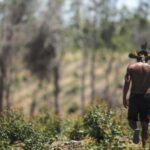Managing risks in a forest investment is a responsibility that sits with several people. Financial risks with the Financial Controller, operational risks with Forest Managers and Investment Managers and ESG risks with the Sustainability Manager and so on. However, the challenge is that many forest investment risks are cross-cutting, and there is a risk of poor risk management. This article looks to shed light on risk responsibility – where if poorly defined, the situation can arise where someone undoubtedly thinks that a risk lies firmly in the responsibility of another – the risk is ignored, and some negative event is incurred. Read on, if you want a streamlined process to identify and manage asset-level risks so that no risks go falling between chairs.

4 Steps to Responsible Risk Management
At the outset of designing a new forest investment strategy, whether for a Fund or for an asset-by-asset mandate, one of the key elements that need to be addressed are the risks. I recommend a team brainstorming session to get all the risks on the table. It is so important that this is a group exercise, because different members of the investment team will bring their own experiences where different risks have surfaced. What’s more, it’s extremely important that all team members are on the same page in understanding the various risks and knowing who is responsible for what. To sum up, this process consists of 4 main steps:
The Risk Identification and Management Brainstorm Process
- Name the risk categories,
- Identify the risks and potential risk mitigation measures within these categories,
- Assess management team and risk responsibility,
- Design the risk management framework.
These are further elaborated below.
1. Categorizing Risk
It may be easiest in your brainstorm session to start with some pre-defined risk categories, to help pull out specific risks. There is no single way to do this, and it will depend on your strategy – but general forest asset investment risk categories could include:
Management
This will differ depending on whether or not the asset to be invested includes a company that executes the forest management, or if it is an asset only – that will rely on 3rd party property managers. How the risk is managed will be different in these scenarios, but it is a consideration for both. Management risks relate to everything from having a qualified CEO to sufficient seasonal day-labor. It addresses items such as corporate governance and business integrity. It looks at the quality of the planning, systems, and procedures. Basically, any risk related to how the forest asset is managed and who manages is a management risk.
Climate / Physical
These risks relate to those that may physically damage the forest asset. This could be fire, storms, drought, pests, disease – and relate to items such as poor survival of planted trees, damaged trees, or catastrophic forest loss. Most of these are climate-related (which is why I have grouped climate and physical risks together).
Market
Market risks relate to any market failure (or failure in the supply chain) limiting the ability to sell the forest products to the expected markets for the expected prices. It could be a reduction in consumer demand, it could be a drop in prices, or prices not increasing as expected. It could also be logistics or processing constraints.
Financial
Financial risks relate to items like discount rate compression not meeting expectations, currency fluctuations, tax, inflation, and in general – budgetary expectations not reflecting the actual financial situation. Financial risks also relate to capital not being called on time, and debt not being serviced on time.
Political / Legal
These risks relate to items such as political instability, corruption, and ease of doing business. This is a risk that is commonly given much more emphasis in tropical, developing jurisdictions over core markets for forest investment. It relates to land tenure security and expropriation of timber or carbon rights. It also relates to forest management legislation and the legislation surrounding the ability to legally produce and sell wood.
ESG
Simply put, these are Environmental, Social and Governance risks, and ESG risks are often cross-cutting. Environmental risks of a forest asset relate to things like fire, erosion, and water contamination. Social risks refer to stakeholder-related risks, including local communities or indigenous groups and reputational risks related to wider stakeholders. Governance risk ties back into management risk – covering corporate governance and business conduct, but also addresses items categorized as political risk.
Exit
Exit risks relate to the risks above that specifically influence the ability for an investor to divest the asset. These may be market related (such as the industry not developing as expected, or a change in consumer preference away from the products derived from the forest asset), politically driven, or may be more related to investor appetite for the forest asset class.
2. Identify and Mitigate Risks
Looking at the above category examples, or the broad categories you define – will help to identify within your group, the specific risks within each category for assets that would be suitable for your strategy. For example, under market risks – you might have price development of carbon credits not as expected. Under climate/physical risks, you could have increased wildfire prevalence. For ESG risks, you might have encroachment pressure from neighboring communities, and so on. Once the risks are identified, as a group, you can think about what safeguards you could put into place to either remove or reduce this risk.
3. Define Risk Responsibility
As the risks have now been laid out, and solutions for how to reduce these risks have been thought through – it is time to decide who is in the best position to oversee each of the risks and/or risk categories. This exercise will require the following considerations:
- Identify the functions and expertise that exists within the team,
- Identify significant cross-cutting risks that may naturally lie with 2 or more people on the management team and define who will take responsibility over what,
- Determine if there will be an overall responsible for Risk management.
The importance of this step cannot be over-stated. It is paramount that each member of the team understands the different risks, and who is responsible for overseeing them. Otherwise, as mentioned at the start of the article, there is additional risk, in that the risk is not managed at all. This situation is elevated when a risk is cross-cutting and seemingly the responsibility of someone else.
Another solution or complement to risk management, is to define a risk responsible person. That is someone on the team, whose responsibility is to oversee all risk. Now, Risk and Compliance is a requirement of most regulated alternative investment funds – but what I mean here is a bit more involved. This is someone on the day-to-day management team and by nature of this, is closer to the risks than the regulatory-appointed Risk and Compliance person, who may not be close to operations at all.
4. Design the Risk Management Framework
Now this is an article all on its own, but after the risks have been identified, safeguards thought through, and responsibility has been defined – you will want to wrap all of this into a management framework. That is – how you will identify, manage and evaluate risk throughout the investment process. It will include the risks you have already identified, set the process for identifying and evaluating new risks, as well as spell out an emergency response plan – for how to manage unforeseen risk events.
Need Help with Designing your Risk Management Framework?
If you are in the process of developing a new forest investment strategy and need some support in designing your risk management framework, please reach out. I lead risk management workshops for teams, to help you identify the risks unique to your strategy, assess who within your team is best suited to manage risks, and set the stage for how these risks will be managed – so that your forest investment has the best chance of reaching its financial and impact objectives.





